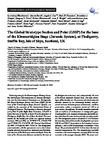The Global Stratotype Section and Point (GSSP) for the base of the Kimmeridgian Stage (Jurassic System), at Flodigarry, Staffin Bay, Isle of Skye, Scotland, UK
| dc.contributor.author | Wierzbowski, A | |
| dc.contributor.author | Barski, M | |
| dc.contributor.author | Coe, AL | |
| dc.contributor.author | Hounslow, MW | |
| dc.contributor.author | Matyja, BA | |
| dc.contributor.author | Price, GD | |
| dc.contributor.author | Wierzbowski, H | |
| dc.contributor.author | Wright, JK | |
| dc.contributor.author | Atrops, WCFF | |
| dc.contributor.author | Grabowski, J | |
| dc.contributor.author | Mattioli, E | |
| dc.contributor.author | Morton, N | |
| dc.contributor.author | Ogg, JG | |
| dc.contributor.author | Olóriz, F | |
| dc.contributor.author | Page, K | |
| dc.contributor.author | Parent, H | |
| dc.contributor.author | Przybylski, P | |
| dc.contributor.author | Schweigert, G | |
| dc.contributor.author | Villaseñor, AB | |
| dc.date.accessioned | 2023-02-20T10:51:06Z | |
| dc.date.available | 2023-02-20T10:51:06Z | |
| dc.date.issued | 2023-01-15 | |
| dc.identifier.issn | 0705-3797 | |
| dc.identifier.issn | 2586-1298 | |
| dc.identifier.uri | http://hdl.handle.net/10026.1/20435 | |
| dc.description.abstract |
Following voting by the Kimmeridgian Working Group, the International Subcommission on Jurassic Stratigraphy and the International Commission on Stratigraphy, the Global Stratotype Section and Point (GSSP) for the base of the Kimmeridgian Stage (Jurassic System) was ratified by the executive of the International Union of Geological Sciences. The boundary is placed in the upper part of Bed 35 of the Staffin Shale Formation, 1.25±0.01 m below the base of Bed 36 in block F6 in the foreshore at Flodigarry, Staffin Bay, Isle of Skye, Scotland. The coordinates for the middle part of the two adjacent sections (sections F6N and F6S) are 57°39'39.5''N, 6°14'43.9''W and 57°39'40.5''N, 6°14'45''W; UK National Grid Scheme NG 4687 7139 and NG 4687 7142±5 m. This stratigraphic point coincides with the appearance over a short stratigraphic interval of several new ammonite taxa that delineate the base of the Subboreal ammonite Baylei Zone, the base of the Densicostata Subzone marked by the base of the flodigarriensis horizon, and, independently, the base of the Boreal ammonite Bauhini Zone. The main advantages of this locality are: the presence of a dual ammonite zonation marked by two extensively studied, well-preserved and very abundant groups of ammonites, and their preservation within a continuous section of ~120 m of open marine, fossiliferous, thermally immature mudrocks with no evidence of condensation or stratigraphic gaps. Dinoflagellate cysts, magnetostratigraphy and stable isotope data from the same section provide secondary markers. The stratigraphic point is located 0.17–0.65 m below the boundary interval between the dinoflagellate cyst zones DSJ 26 and DSJ 27 (equivalent to the boundary between subzones c and d of the Scriniodinium crystallinum (=Scr) Zone). The point is located 0.02–0.24 m above the base of reversed magnetozone F3r. This magnetozone probably correlates with marine magnetic anomaly M26r but may correlate to the younger anomaly M25r. The point coin cides with a well-marked broad minimum in δ13C values and a calculated low Sr-isotope value of 0.70687. The section has yielded nannofossils that show that the potential last occurrence of Octopodorhabdus decussatus that marks the lower part of the NJ15 zone occurs about 1.09 m below the boundary. The thermal immaturity and unweathered nature of the strata in the Flodigarry section has permitted a direct Re-Os radio-isotopic age of 154.1±2.2 Ma to be obtained from the mudrocks 0.05 m below the Kimmeridgian GSSP. Sequence stratigraphic analysis indicates that the GSSP lies within the lower part of a highstand system tract. The corresponding stratigraphic level in the Submediterranean-Mediterranean successions is close to the boundary between the Hypselum and Bimammatum ammonite zones. The change in ammonite groups noted at this level provides biostratigraphic markers for further global correlation. | |
| dc.format.extent | 281-307 | |
| dc.language | en | |
| dc.language.iso | en | |
| dc.publisher | International Union of Geological Sciences | |
| dc.subject | 37 Earth Sciences | |
| dc.subject | 3705 Geology | |
| dc.title | The Global Stratotype Section and Point (GSSP) for the base of the Kimmeridgian Stage (Jurassic System), at Flodigarry, Staffin Bay, Isle of Skye, Scotland, UK | |
| dc.type | journal-article | |
| dc.type | Article | |
| plymouth.issue | 2 | |
| plymouth.volume | 46 | |
| plymouth.publication-status | Published | |
| plymouth.journal | Episodes | |
| dc.identifier.doi | 10.18814/epiiugs/2022/022046 | |
| plymouth.organisational-group | /Plymouth | |
| plymouth.organisational-group | /Plymouth/Faculty of Science and Engineering | |
| plymouth.organisational-group | /Plymouth/Faculty of Science and Engineering/School of Geography, Earth and Environmental Sciences | |
| plymouth.organisational-group | /Plymouth/REF 2021 Researchers by UoA | |
| plymouth.organisational-group | /Plymouth/REF 2021 Researchers by UoA/UoA07 Earth Systems and Environmental Sciences | |
| plymouth.organisational-group | /Plymouth/Research Groups | |
| plymouth.organisational-group | /Plymouth/Research Groups/Marine Institute | |
| plymouth.organisational-group | /Plymouth/Users by role | |
| plymouth.organisational-group | /Plymouth/Users by role/Academics | |
| plymouth.organisational-group | /Plymouth/Users by role/Researchers in ResearchFish submission | |
| dcterms.dateAccepted | 2022-11-24 | |
| dc.rights.embargodate | 2023-2-21 | |
| dc.identifier.eissn | 2586-1298 | |
| dc.rights.embargoperiod | Not known | |
| rioxxterms.versionofrecord | 10.18814/epiiugs/2022/022046 | |
| rioxxterms.licenseref.uri | http://www.rioxx.net/licenses/all-rights-reserved | |
| rioxxterms.type | Journal Article/Review |


